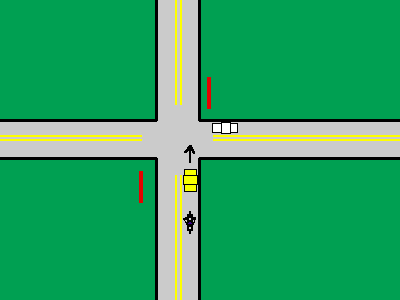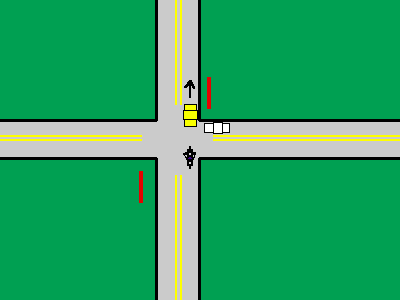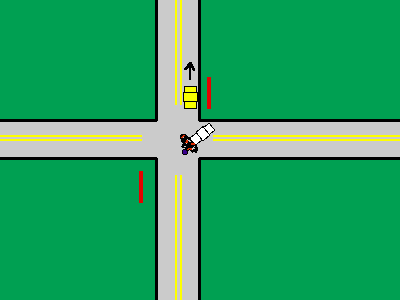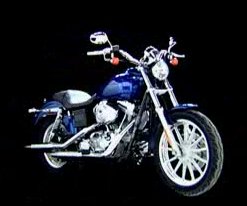Motorcycle / Scooter Safety
by John Nozum
Thinking about getting that new motorcycle or
2-wheeled
powered scooter? Here are some things to know from legal and
safety
standpoints, so that you don't get creamed and/or end up the
slammer--or
even the grave! Below are some things that motorcycle
test prep guides either don't mention or don't empathize well enough.
Ideally, beginners should practice on paved
parking
lots that are not in current use or on driver ed courses. This is
PARTICULARLY so if you have never ridden a bicycle. You should be
able to confidently ride a bicycle before you try to hop on a
motorcycle
or scooter. The next step should be light city driving, where the
speed limits are around 15-25 MPH. You should stick to city
driving
in light traffic conditions for at least 2-3 weeks.
On a more intermediate level, you may want to try
semi-highway driving, where speed limits are 35-40 MPH.
Alternatively,
you may wish to try a little country driving at short distances.
To learn more about country driving, click
here.
At any rate, USE YOUR REAR VIEW MIRRORS
FREQUENTLY!!!
This is particularly so if you are not comfortable driving at the speed
limit. You don't want an impatient driver on your tail! If
such is the case, it is best to CAREFULLY pull over and let the
impatient
driver ahead of you. That way, you're both happy, and you're much
safer.
Another word of caution, particularly for less
experienced
drivers: Do not stare at your instrument panel or mirrors for
very
long. It should take no more than 0.5 to 1 second to check a
mirror
or instrument on your dash board. Back around 1978 or so, I
FLIPPED
OVER on my bicycle because I was looking at my speedometer and not
where
I was going! At least 80% of your viewing time should be on the
road
ahead.
The following documentation is REQUIRED before
you
can take that motorcycle or scooter out on the road:
- License (can be the following)
- Driver's license with
motorcycle endorcement
- Motorcycle license
- Motorcycle permit
- Proof of insurance
- Vehicle registration
- License plate (or at least a temporary plate)
As for scooters, this varies state by state. Many states
regulate
scooters the same as bicycles IF the engine is smaller than 50
cc.
In this case, insurace, license, registration, and helmet are not
required. Moreover, insurance is often very difficult to obtain
for
small scooters (engine under 50 cc). Scooters 50 cc and over are
regulated the same as motorcycles. Also, scooters may be
regulated
at the CITY level! Even if scooters are legal in your state (AND
CITY), you are required to obey the traffic laws like everyone
else.
In fact, because scooters are exempt from licensure laws in some
states,
local police may be quicker to pull over someone on a scooter than in a
car, even for the same type of violation.
Scooters have four major safety concerns that are
unique to them. First of all, many scooters are quite small and
are
not easily seen by other motorists. This is particularly true of
scooters smaller than 50 cc. Many scooters do not have all the
safety
features that a street-legal motorcycle has, such as mirrors, signal
lights,
brake light, and headlight. Even when these are present, the
quality
may be inferior in such a way that they may not be what they're cracked
up to be. For example, brake lights may not be noticeable in
bright
sunlight. Signal lights may not be seen by other drivers.
Many
scooters have wheels that are quite small, and these are much more
prone
to getting caught in road defects, such as potholes. As a result,
the front wheel may get caught in one of these defects, and the WHOLE
BIKE
may end up flipping over, causing serious injury or even death!
Finally,
many scooters are built with lightweight materials, including plastics,
and SO LONG if you get involved in an accident involving a car or even
bigger vehicle!
There is a very common accident scenario that is
common to motorcycles and scooters. Here is how it often
happens:
Suppose you are on a motorcycle or scooter and are following a car that
is ahead of you. You approach an intersection, planning on going
straight ahead. A car is stopped at a road that is perpendicular
to the road that you are on and sees the car that is ahead of
you.
The car ahead of you gets past the intersection without any
events.
However, because the person in this other car (on the road
perpendicular
to you) saw the car that was ahead of you and NOT YOU, YOU end up
getting
creamed! Below is a slide-by-slide view:

Please note the motorcyclist following the yellow car closely.
Also
note the white car that is waiting to turn onto your road.

Now notice that the yellow car in which you are following
successfully made it almost through intersection. He is fine.

Because the driver in the white car did NOT see you,
you get CREAMED!
Remember that when there is an accident involving a motorcycle and a
car, the car ALWAYS "wins"!!! A motorcycle plus its rider(s)
rarely
exceeds 1,000 pounds. However, most cars are over 3,000
pounds.
Also, a motorcycle has only 2 wheels, and a car has 4 wheels, which
means
that a car has more stability, particularly in an accident. Both
broad side and head-on collisions are particularly gruesome. In
severe
cases, a motorcylist can be BEHEADED! Such was the case in
Pennsylvania
in 2004; The helmet was picked up, and the head was still in it!
There are some unique hazards and such when it
comes
to motorcycles and scooters. To learn more about these, click
HERE.
Many people do not know the difference between a
scooter and a motorcycle. Click
HERE to see the differences.
To learn more about helmets and why they are
important
even in states where they're "optional", click
HERE.
If you're in the mood to try some country
drivin',
click
HERE.
To read all about my accident on September 4,
2004,
click HERE.

Think you're ready to take that
Harley out on the highway just yet?
CLICK HERE to see if you're ready!
Return to
Main
Menu



